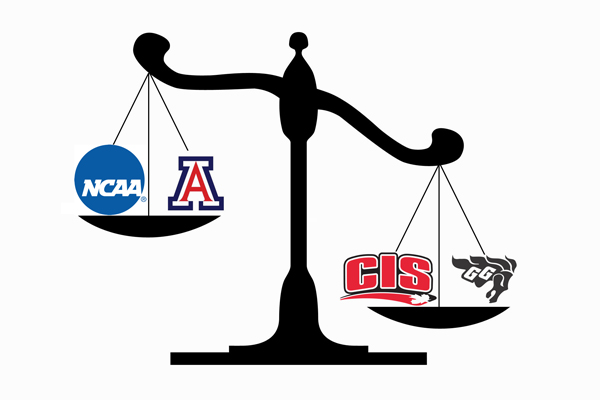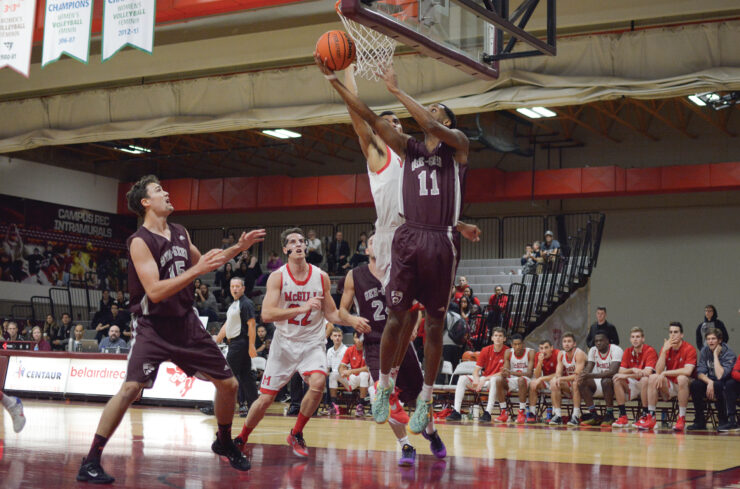How North America’s second-ranked college basketball teams sum up problems with university athletics
Graphic by Spencer Murdock
Be it in the NBA or the driveway, basketball’s history is very deeply rooted in North American society. Created by a Canadian in America nearly 125 years ago, basketball has since become one of the premier collegiate sports across the continent. Despite this, there are still issues tormenting basketball’s two major nations, a significant one being the striking disparity between the United States and Canada when it comes to collegiate hoops.
Regardless of the country, being a top-ranked basketball team takes a very precise mixture of skills, talent, work ethic, toughness, will to win, and leadership among other traits to be successful. Despite this, a clear divide is still present between nations. To articulate this, the Fulcrum will compare the second-ranked teams of both respective countries: the Ottawa Gee-Gees and the Arizona Wildcats.
The 18–2 Gee-Gees men’s basketball team represents the University of Ottawa in Canadian Interuniversity Sport (CIS) while the 22–1 Arizona Wildcats men’s basketball team represents the University of Arizona (Tucson, Ariz.) in the National Collegiate Athletic Association (NCAA) Division I.
The typical assumption is that older and larger schools tend to have better programs. Unfortunately that is the only area in which the U of O has the advantage. Ottawa is the older school of the two, established in 1848, and has a higher student enrollment with 42,027. The U of A was established in 1885 and has an enrolment of 39,113. The real difference between schools comes down to dollars. Arizona is around $350 million richer, which means that they have a substantially higher budget for athletics and, more tellingly, scholarships.
The biggest difference between Canadian and American programs is all in scholarships. At Arizona, most if not all of the players on the team carry a full-ride scholarship, which essentially means they go to school at no cost as long as they play. That is the norm among most NCAA institutions. In Canada, there is typically no full-ride ever given out and at Ottawa specifically, players can receive $3,500 per year if they maintain an 80 per cent average. This academic expectation can sometimes be unrealistic due to busy schedules and missed classes that athletes have to endure compounded with the variety in programs.
Another disparity between the teams comes in terms of recruitment. Out of 16 players on the Wildcats, only four come from within the state, while on the other hand, seven of 15 players on the Gee-Gees hail from the Ottawa area. This is an essential difference between countries; players will come from across America to play at winning programs whereas players are much likelier to stay local in Canada — and that’s if they stay in the country. Canadian players often choose to cross the border to play college ball. This can be seen in the 97 Canadians on NCAA Division I rosters in 2014. Most notably, Toronto native Andrew Wiggins is the shining beacon of Canadian basketball hope: He is starting as a freshman for the eighth-ranked NCAA Division I Kansas Jayhawks and will also be a shoo-in for top NBA draft pick in June. He’s on his way to making millions of dollars at the ripe young age of 19.
Imagine yourself a young Canadian player looking to continue your basketball career after high school, with the opportunity to play in either country. You could come to Ottawa and play for four years, potentially hustle your way into playing pro ball in Europe just like Gee-Gee alumnus Warren Ward. Or, on the other hand, you could go to Arizona, play for one year, potentially move on to the NBA, and live your dream. Which option do you think you’d choose?
The answer is obvious: Arizona over Ottawa almost every time.
The CIS soon has to come to grips with how much more attractive the NCAA is for Canadians. The scholarships and national exposure that Canada does not offer kills the schools’ chances of landing top recruits. Something clearly has to be done before the CIS basketball system winds up in shambles while more key talent flees to greener southern pastures.






